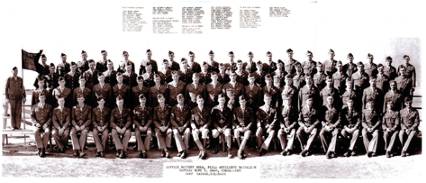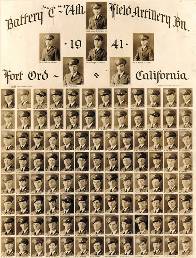|
Ralph B. Lawson enlisted in the army at the Federal Building in Tulsa,
Oklahoma on July 6, 1938 at the age of seventeen. He was sent to Fort
Sill in Lawton, Oklahoma where he received basic training and was
assigned to the 18th Field Artillery, a horse-drawn artillery unit. In
December, 1938, when the 12th Field Artillery based at Fort Sam
Houston in San Antonio, Texas was motorized, Ralph was one of the
soldiers that rode the horses and equipment the 400 plus miles from
San Antonio to Lawton. The trip took about 5 weeks. The soldiers would
stop for the night at farms, ranches and county fairgrounds. After
arriving back at Fort Sill, Ralph's education continued. He learned
how the battalion's battlefield communications network operated. He
was taught the art of dispensing telephone wire off a reel cart pulled
by a team of horses. Ralph quickly excelled at the operation of field
telephones at the forward observer and gun positions as well as the
switchboard that connected it all together. It was his mastery of
these communications skills that allowed him the ability to quickly
rise to the rank of signals sergeant. Ralph was later transferred to
the 74th Field Artillery stationed at Fort Ord, California. He was
discharged July 9, 1941.
36 days later, on August 14, 1941, Ralph re-enlisted in the army in
Oklahoma City, Oklahoma. He was sent to Camp Roberts, California to
retake basic training and to learn to drive a heavy truck. After
completing training, he was sent to Fort Warren Wyoming as an active
duty member of the 183rd Field Artillery, Idaho National Guard. Ralph
was at Fort Warren when the Japanese bombed Pearl Harbor.
While on maneuvers with the Idaho National Guard at Camp Murray,
Washington, Ralph visited the main post at Fort Lewis. He found
himself at the stables inquiring about the unit and asking to speak
with the commanding officer. After a brief informal interview, he
asked to transfer into the unit. Ralph's request to transfer to the
98th Mule Pack Artillery was granted. The 98th was soon sent to Camp
Carson, Colorado to train with the 10th Mountain Division. By order of
General MacArthur, the 98th was transported by troop train to Newport
News, Virginia to begin the journey to Port Moresby, New Guinea via
the Panama Canal, the Society Islands, New Caledonia, and Australia.
In September, 1943, President Roosevelt issued a request for
volunteers for a dangerous and hazardous mission. Ralph was among 129
members of the 98th that volunteered. The volunteers were transported
back to Australia to await the arrival of the troop ship USS Lurline.
The Lurline contained other volunteers of Ralph's new unit, the 5307th
Composite Unit. They soon arrived in Bombay, India where they traveled
by train to Deogarh, India for five weeks of specialized training in
long range penetration. After reviewing army personnel records,
Lieutenant Logan Weston hand-picked Ralph and the other men in his
reconnaissance and intelligence platoon. At the end of training,
General Frank D. Merrill assumed command of the unit. A reporter later
dubbed them "Merrill's Marauders" for their hit and run guerilla
tactics.
On February 22, 1944, the 5307th became the first U.S. ground combat
force to fight on the continent of Asia in World War II. Crossing into
Japanese controlled Burma, via the Ledo Road, the members of the
5307th traversed the many mountains, rivers, and dense jungles of
Burma that stood before them. They faced the experienced 18th division
of the Japanese army, strange and exotic tropical diseases, fatigue,
starvation, and difficult terrain without the possibility of
reinforcements. The Marauders relied entirely upon parachute airdrop
for re-supply. This sometimes meant that the soldiers would go hungry
for days if the weather was bad or the fighting too intense. K-rations
were the primary source of food during the campaign. Designed for
three to four day maneuvers, they did not provide adequate caloric
intake for the strenuous activity asked of the volunteers and only
allowed for a controlled starvation. Medical evacuation of the sick
and wounded also proved difficult. It sometimes required that the
soldiers being evacuated would have to be carried miles to a clearing
so that they could be loaded onto small L-4 or L-5 observation planes
to be flown to more advanced medical care. Mules were used to carry
light machine guns, mortars, radio equipment and other vital supplies.
The difficult terrain sometimes required the men to unload the mule,
carry the load up the difficult section of the trail, reload the mule
and continue on. The Marauders worked closely with Detachment 101 of
the O.S.S. and the indigenous population, a tactic still used by
United States special forces. During the battle of Nhpum Ga Hill, the
need for artillery arose when one of the Marauder's units was cut off
and surrounded by a superior Japanese force. Former members of the
98th Mule Pack Artillery were familiar with the operation of the pack
howitzer and quickly assembled two guns within fifteen minutes of
their being air dropped. Ralph was called on for his communication
experience to act as a forward observer telephone operator. The
artillery turned the tide of the battle and allowed the rescue of the
besieged unit.
Fighting in 3 major battles and 32 minor engagements, the Marauders
were given a Presidential Unit Citation for capturing the Japanese
airfield at Myitkyina. After the fall of the airfield, Ralph, like
others in his unit, was experiencing the side effects from months of
jungle fighting, fatigue, improper diet, and a fever of unknown
origin. He was evacuated to the 20th Field Hospital in Assam province,
India. By the time they had completed their mission, over eighty-five
percent of the men of the 5307th were unfit for duty due to tropical
disease, malnutrition, exhaustion, or battle wounds. After the fall of
the city of Myitkyina, those soldiers who would be unfit for combat
within sixty days were sent back to the United States. Ralph traveled
by train to Karachi, India, now Karachi, Pakistan, then by air on to
Tehran, Iran, Cairo, Egypt, Tripoli, Lybia, Casablanca, Morocco,
Bermuda, Miami, Florida, and by train to Hot Springs, Arkansas. The
1850th Service Command Unit, Camp Chaffee, Arkansas would serve as
Ralph's last post. It was at Camp Chaffee that Ralph was discharged on
June 2, 1945. He married Ida Bell Estep the next day in Wagoner,
Oklahoma. They have been married ever since. Ralph and Ida settled in
Catoosa, Oklahoma where they have lived the last 44 years and raised
their two boys. After retiring in 1983, Ralph has been active in the
Disabled American Veterans, and volunteered at The Claremore Veteran's
Hospital, The Veteran's Administration Hospital in Muskogee, Oklahoma,
and the Tulsa Outpatient Clinic of the Veteran's Administration. Ralph
is proud of his army past and doesn't hesitate to share his
experiences with anyone he meets.
|
|

Enlargement feature for above image to come soon.

98th Field Artillery Pack
group photo (above)
Battery C 74th FA. class photo
(left)
Enlargement feature
Click image to
view larger -
use cursor to
drag image around
or use
scrollbars.
Click to view larger image: 1MB download |
Sergeant Lawson served in the following units:
• 18th Field Artillery Fort Sill, Oklahoma
• 74th Field Artillery Fort Ord, California
• 183rd Field Artillery Fort Warren, Wyoming
• 98th Mule Pack Artillery Fort Lewis, Washington
• Port Moresby, New Guinea
• 5307th Composite Unit India
• Burma
• 1850th Service Command Unit Camp Chaffee, Arkansas
Awards and Citations:
• Bronze Star
• American Service Ribbon
• American Defense Ribbon
• Asiatic-Pacific Medal
• Combat Infantry Badge
• Good Conduct Medal
• Presidential Unit Citation
• China Victory Medal Taiwan, Republic of China
2004 Inductee Oklahoma Military Hall of Fame |